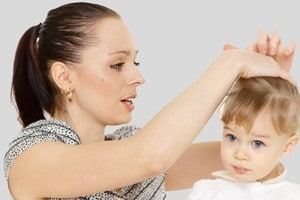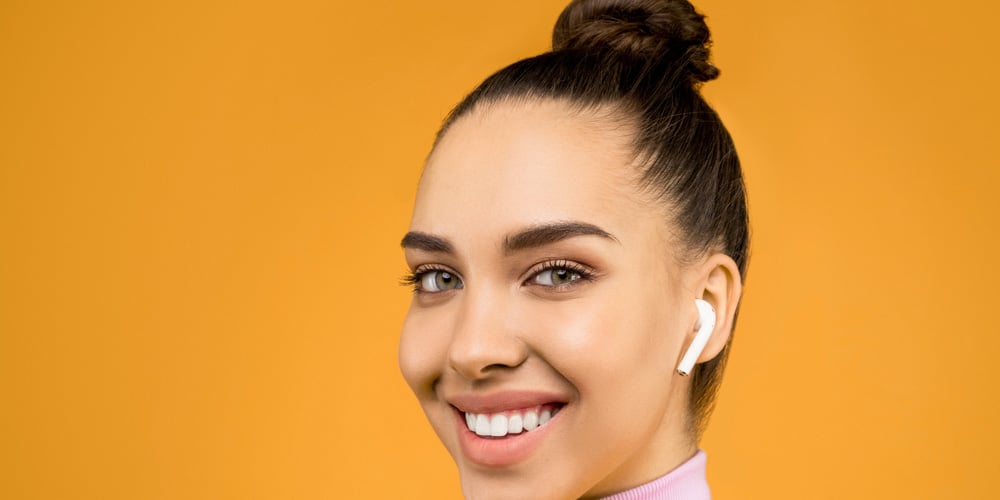A distinction is usually made between two types of traction alopecia : one is caused by a certain type of hairstyle, the other by bad habits (in children) and/or a behavioural disorder called trichotillomania (from the Greek for 'hair' and 'pulling').
As the name suggests, this type of hair loss is caused by the 'pull' exerted on the roots by certain types of hairstyle, provided of course that the action is repeated over and over again over time.
A typical example of traction alopecia is that of the dancer who systematically pulls her hair into a perfect, tight bun for long periods, even years.
But in reality, traction alopecia is a form of hair loss that can affect both men and women, whatever their hair type, Caucasian or Afro-Crossbred.
What is the process of traction alopecia?

On the surface, the tension permanently inflicted on the hair destroys the chains of keratin and weakens the shafts. Hair breaks at every length. Under the scalp, the roots separate from their hair follicles. With insufficient blood supply, the hair moves more quickly from the growth phase to the telogen phase (Cf. The life cycle of a hair) and fall out. Too often called upon to produce new hair, the follicles shrink and produce thinner and thinner regrowth. Then, when their number of renewal cycles is exhausted, production stops.
As a result, the hair enters the telogen phase earlier and earlier, the hair capital is depleted prematurely and thinning areas appear. Eventually, there's a real risk of ending up with very thinning areas, or even complete baldness, with little hope of regrowth.
At this stage, once the pores have closed, no treatment can reactivate the hair follicles. Hair loss is definitive.
These thinning areas are located in well-defined places on the skull, often depending on the type of hairstyle.
At one time, women who traditionally wore their hair in a bun (hence the name "bun alopecia", which is still sometimes used) saw their skulls recede more towards the top. Today, with the diversity of hairstyles: ponytail, bun, chignon, but also braids and various Afro hairstyles, thinning areas are tending to diversify, unfortunately. But the result is always the same: an accelerated hair life cycle that produces increasingly fragile hair and, ultimately, little or no regrowth.
What are the consequences of traction alopecia caused by hairstyles?
There are two main consequences:
- Hair refinement : Refined hair is weakened and tends to break frequently. The keratin is damaged, the hair loses its natural elasticity and becomes increasingly tangled. The thinner it becomes, the more prematurely it falls out because it renews itself too quickly.
- Localised absence of regrowth: a direct consequence of the progressive thinning of the hair. Once reduced to a downy state, hair is no longer able to produce solid hair, the capital (the theoretical reserve) of hair is severely depleted and it will become difficult to stimulate healthy, long-lasting regrowth.
At the same time, the traction exerted on the roots can cause minor irritation and insidious inflammation of the scalp. A topical treatment is then recommended to soothe the scalp.
And if, in addition, the scalp is sensitive to the harmful action of androgens, it's a 'double whammy' in the short term, with hair follicles weakened by the effects of androgenetic alopecia.
How can you recognise hair loss (or traction alopecia) linked to hairstyling?
The thinning areas of the scalp are where the hair has been pulled to achieve the desired style. These areas will be different from the "classic" areas linked to androgenetic alopecia. We will therefore have thinning around the edges (forehead area), above the ears and at the temples from pulling the hair tightly into buns, ponytails or catogans. In the case of Afro hairstyles, this depends on the type of hairstyle; also beware of the frequent use of weaves and extensions, which will pull on the hair and produce the same effect as hairstyles on natural hair - these manipulations, if poorly carried out and applied for long periods without allowing the scalp to breathe, will have deleterious effects on healthy hair growth. The weakened areas will then be spread throughout the scalp. There is also a clear recession in the forehead area, which can be as much as several centimetres at the front, giving the false impression that the forehead is growing.
When you style your children's hair, you may want to see them "change their head" and have them sport little pigtails or more sophisticated hairstyles in the case of Afro or mixed-race hair. It's all very cute but... there's a risk of drawing on their hair capital far too early and triggering an acceleration in hair renewal, resulting in fragile hair from adolescence onwards. If this type of hairstyle becomes commonplace (as a result of fashion, hair experiments, etc.), the result can be marked traction alopecia before the age of 20.
What about trichotillomania?
Trichotillomania is a behavioural disorder that involves compulsive and regular pulling out of one's hair (or any other hair: eyebrows, eyelashes, etc.). In children, trichotillomania is often a simple tic, such as thumb sucking or nail biting. It's something they often do without being fully aware of it, and it gives them a feeling of relief.
Children fall asleep or do their homework by twisting and pulling their hair. Only one side of the scalp is usually affected: the side that is easiest to reach, depending on whether the subject is right- or left-handed. In clearly defined areas, the hair is broken, shortened and cut to different lengths. Over time, patches of atrophied hair form. For a specialist, it's easy not to confuse these patches with those of alopecia. This behavioural disorder is not to be taken lightly, as it may be an expression of malaise in toddlers and young children. Rest assured, however, that this is often a transitory phase with no consequences for the child's development or hair growth later on. In the vast majority of cases, the disorder disappears when the child grows up.
Much more serious, but also much rarer, cases occur in adults. No study to date has succeeded in identifying the fundamental causes of this pathological behaviour. We only know that 9 out of every 10 people suffering from this disorder in adulthood are women. This compulsive and obsessive plucking has no cosmetic or aesthetic purpose, but it is frequent and regular to the point of causing a visible weakening of the hair. Irregular, more or less hairless patches form on the scalp, which are impossible to conceal except with wigs or other hair supplements. The hair forms small, fluffy clumps in the areas most affected.
The attack occurs when the person is anxious or depressed, and pulling out the hair provides a feeling of relief. Symptoms of trichotillomania in adults include the presence of a number of rituals that accompany the pulling out of hair. Unable to control their impulse, and often ashamed, sufferers of this pathology will try to hide their symptoms and will often make numerous attempts to put an end to their practice. The solution lies with a specialist, through behavioural therapy and/or medical treatment (anti-depressants).
What can be done to treat hair loss in the case of trichotillomania?
When an adult suffers from trichotillomania, one of the difficulties is becoming aware of the illness. Once this stage has been reached, starting a treatment to stimulate hair regrowth will inevitably have an impact on morale. By taking care of themselves and applying effective, natural products according to a protocol that replaces the rituals of pulling out hair, sufferers can regain their confidence and hope to repair the damage they have caused. However, the following should be noted When hair follicles have been inactive for more than 10 or 12 months, they cannot be resuscitated. However, it is possible to reactivate dormant follicles and get them to produce new growth again. Of course, this will be a long-term process. It is no substitute for therapy that addresses the underlying causes of the disorder.
Traction alopecia due to hairstyles or pulling:
different causes but identical consequences
Pulling on your hair too much or pulling it out during anxiety attacks has the same effect: the hair's vital cycle is completely disrupted and the hair follicle is over-solicited, unable to produce healthy hair. The result, sooner or later, is that the hair becomes increasingly fine, fragile and brittle. It no longer renews itself at a normal growth rate, thinning areas appear on the scalp, the hair looks like fine down, and finally, the hair follicles, exhausted, have reached the end of their production capacity (hair capital): no more hair grows back.
What should be done about traction alopecia? What is the appropriate treatment for traction alopecia?
It's vital to act before it's too late. First of all, of course, free your hair and stop any hairstyle or manipulation that is lethal to the hair. A more flexible bun or ponytail, looser plaits, etc., if there's nothing else you can do. In the case of trichotillomania, you should seek the help of a health professional who will be able to identify the symptoms of the disease: you shouldn't be ashamed to seek help.
And then, above all, we implement an appropriate care protocol to stimulate the regrowth of healthier hair. Hair lotion to relax the scalp, serums concentrated in anti-hair loss active ingredients to nourish the hair follicle and encourage hair to grow back full of vitality, not forgetting nourishing creams and balms to repair damaged keratin.
Your questions
What is traction alopecia?
Traction alopecia is the result of repeated bad hair habits: buns that are pulled too tight, extensions that are too heavy and poorly executed, weaves that are too tight, etc. By pulling too hard on the hair, it ends up falling out prematurely, disrupting its normal life cycle. Eventually the hair follicles are no longer able to produce healthy new hair, areas of high tension become sparse (edges, temples) and all that's left is a little fuzz. Trichotillomania, the compulsive and uncontrolled plucking of hair, produces the same effects.
How is traction alopecia treated?
The first thing to do is to release the pressure in every sense of the word! We leave our hair as free as possible, avoid braiding too tightly and any hairstyles or manipulations that regularly pull hard on the hair. A nourishing treatment to repair weakened keratin and a special regrowth treatment are recommended to stimulate the growth of new hair full of vitality. In the case of pathological behaviour, therapeutic support may prove useful.

